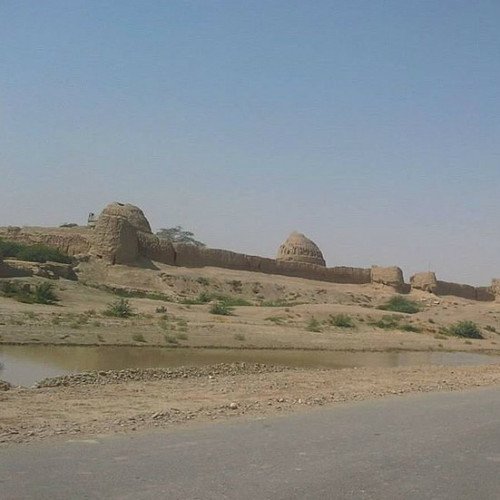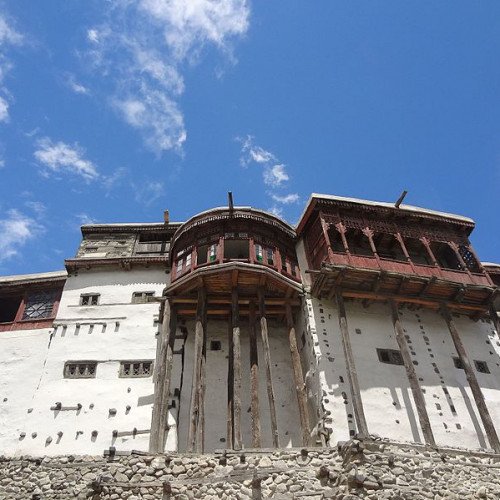Castles of "Pakistan" SIBI FORT vs BALTIT FORT

SIBI FORT
The Sibi Fort is situated in Sibi city of Balochistan Province, Pakistan. The Sibi (Siwi) was popular place of the Chachnama that the King Chach defeated Sewas, pushing them out of this place captured Sibi Fort. The Hindu rulers Sewas had kept this for some time but lost to king Chach in 550 A.D. The Brahman rule continued here till the early part of eighth century A.D. When the young Arab general conquered the whole of these areas, In the 11th century Sibi was included in Ghaznavid Empire. The Muslims rule remained it included in the Suba Multan under Nasir ul din Kabacha (1210-1228 A.D.) According to the Book "Ain-e-Akbari" the Sibi Fort was in control by Jam Nizamuddin of Sindh as a Province in 1488 A.D. At the end of 15th century Sibi Fort was ruled by Sultan Pur-Dil Barlas whose forces were thrown out of the Fort by the forces of Shah Beg Arghun of Arghun dynasty. In 1543 A.D. Sibi Fort was visited by the fugitive Mughal king Humayun along with his infant son Akbar, the future Great Mughal and the emperor of India. The father and the son found the Arghuns in possession of the Fort. Mulla Mehumd Jiskani the Author of Tazkir-ul-Bar assigns 15th century A.D. for the occupation of Sibi by the Pannis. According to the Akbar Namah of Abul Fazal and Akbar Nama of Faizi Sarhindi by 1575 A.D. Panni (Pashtun tribe) were already in control of Sibi Fort. They must have been present in the general area of Sibi much before. The Government records of Sibi District Government shows that Dehpal a panni Tribe lived in Sibi Fort they still possess the land adjacent to the Fort, the villages Dehpal Kalan and Dehpal Khurd of Dehpal tribe is situated near the Fort. They lived and built the rooms inside the Sibi Fort ruins.
Statistics for this Xoptio

BALTIT FORT
Baltit Fort (Urdu: قلعہ بلتت) is a fort in the Hunza valley, near the town of Karimabad, in the Gilgit-Baltistan region of northern Pakistan. Founded in the 8th CE, it has been on the UNESCO World Heritage Tentative list since 2004. In the past, the survival of the feudal regime of Hunza was ensured by the impressive fort, which overlooks Karimabad. The foundations of the fort date back to 700 years ago, with rebuilds and alterations over the centuries. In the 16th century the local prince married a princess from Baltistan who brought master Balti craftsmen to renovate the building as part of her dowry. The Mirs of Hunza abandoned the fort in 1945, and moved to a new palace down the hill. The fort started to decay which caused concern that it might possibly fall into ruin. Following a survey by the Royal Geographical Society of London a restoration programme was initiated and supported by the Aga Khan Trust for Culture Historic Cities Support Programme. The programme was completed in 1996 and the fort is now a museum run by the Baltit Heritage Trust. In the past several small independent states formed part of the history of the Northern Areas of Pakistan. Among them Hunza and Nager were traditional rival states, situated on opposite sides of the Hunza (Kanjut) river. The rulers of these two states, Mirs known as Thum (also Tham, Thom or Thámo), built various strongholds to consolidate their power. According to historical sources, the Hunza rulers initially resided in nearby Altit Fort, but after a conflict between the two sons of the ruler Sultan, Shah Abbas (Shάboos) and Ali Khan (Aliqhάn), Shaboos moved to Baltit Fort, making it the capital seat of Hunza. The power struggle between the two brothers eventually resulted in the death of younger one, and so Baltit Fort became the prime seat of power in the Hunza state. The fort's construction and design were influenced by those in Tibet. Ayasho II, Thum/Mir of Hunza in the early 15th fifteenth century married Princess Shah Khatoon (Sha Qhatun) from Baltistan (in Moghul history Baltistan is called Tibet Khurd, which means Little Tibet), and was the first to modify the face of Altit and, subsequently Baltit Fort. Baltistan had a very strong cultural and ethnical relation with the Ladakh territory to the east. Not surprisingly, the structure of Baltit Fort was influenced by Ladakhi/Tibetan architecture, with some resemblance to the Potala Palace in Lhasa. Then additions, renovations and changes to the building were being made through the centuries by a long line of following rulers of Hunza. Home of many ancient forts, the Northern Areas of Pakistan lost some of its heritage around the 19th century as a result of attacks by the Maharaja of Kashmir. However, one of the biggest changes in the structure of the Baltit Fort came with the invasion of the British in December 1891. Safdarali Khan, ruler of Hunza and his (Wazir Dadu) (Thara Baig III), fled to befriended Kashgar (China) to seek 'political asylum' with their fellows and families. With the conquest of Hunza and Nager states the fortified wall and watch towers of the old Baltit village and watch towers of the Baltit Fort on its north-western end were demolished as required by the British. They installed his younger brother, Sir Muhammad Nazim Khan K.C.I.E, as the ruler of Hunza state in September 1892.